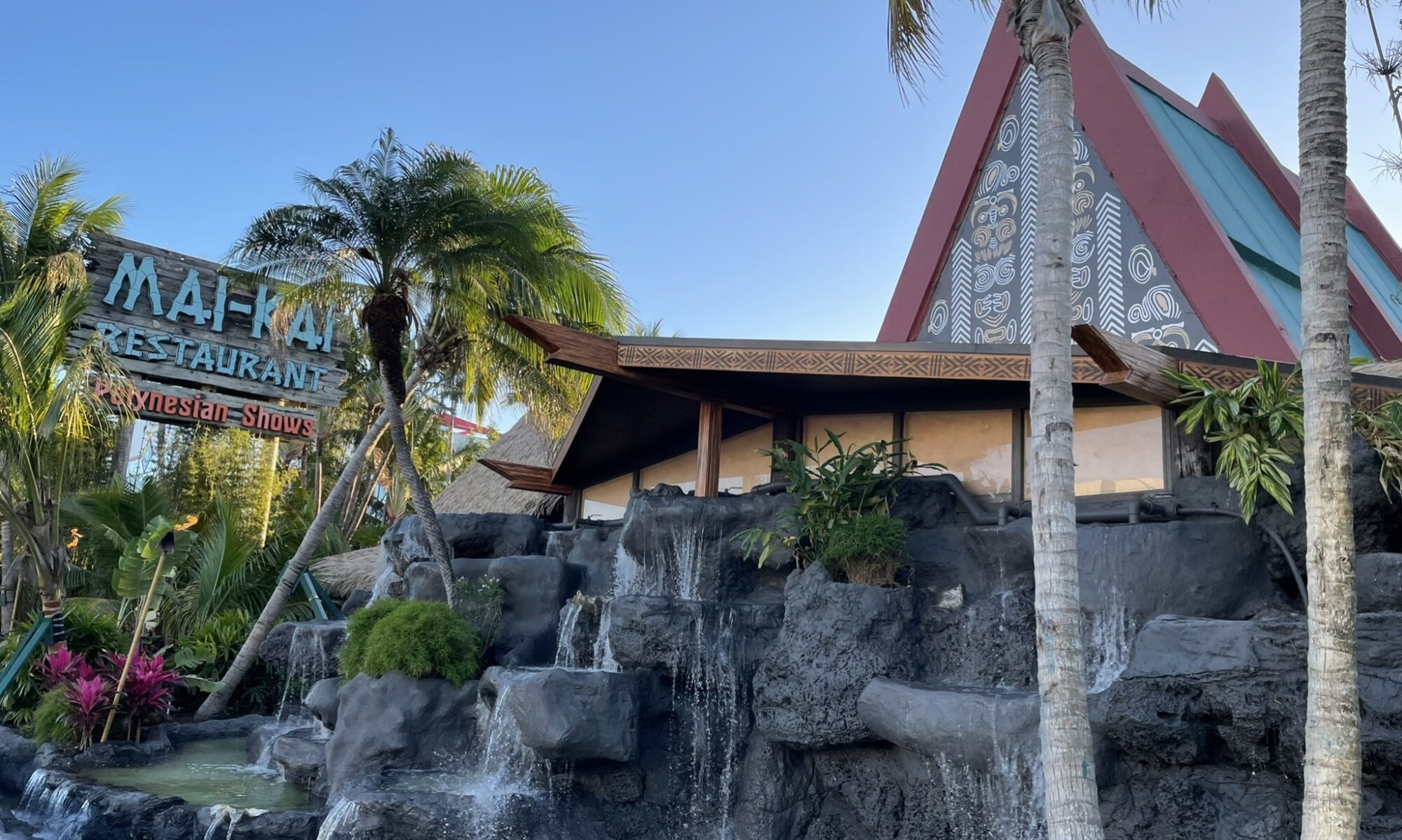Updated June 2019
Thanks to a dedicated group of artists and supporters, The Mai-Kai in Fort Lauderdale has been blessed with the arrival of a new clan of Tiki carvings, most notably the 10-foot “King Kai” that now holds court in the outdoor garden. It’s believed to be the most extensive infusion of large stylized carvings since the 1960s.
See below: Exclusive photo gallery of King Kai, new trio of Tikis | What else is new

King Kai, a Hawaiian Ku design carved by Fort Lauderdale artist Will Anders, was installed May 21 and christened during a special ceremony the next day. Anders had lots of help in realizing the project, which was the vision of The Hukilau’s Christie “Tiki Kiliki” White. She enlisted several key people to make the dream a reality: Securing two Florida Black Olive tree trunks and transporting them to South Florida, then erecting the finished carving at The Mai-Kai.
* See previous coverage
Those responsible are credited on a plaque that adorns King Kai’s base: White, Anders, Lonnie Dryden (who donated the heavy equipment used to transport the logs and helped install King Kai), Lee Cicchella of Paradise Found Landscaping (who donated the two trees), Pete Ginn (who also donated heavy equipment), plus Virginia Decker. That second giant log is sitting in Anders’ workshop, awaiting a future project. Stay tuned.
As if that weren’t enough, however, White also spearheaded a project to replace the three crumbling Tikis that greeted guests upon their arrival by car in the porte-cochère of the landmark restaurant, recently named to the National Register of Historic Places. In the first project of its kind at The Mai-Kai, three Florida artists joined forces to each carve a distinctive new Tiki.

The Tikis carved by Anders, Fort Lauderdale’s Tom Fowner and Tampa’s Jeff Chouinard were installed on May 28-29, just in time for The Hukilau. The Hawaiian Lono (Anders), Marquesan (Chouinard) and Tangaroa-style (Fowner) Tikis were carved by the artists from Central Florida Cypress. The Tikis they replaced were historic, believed to date back to the restaurant’s inception in 1956, but were in a serious state of decay. We’re told that the remnants might find a place inside the restaurant amid the many other South Seas artifacts.
As Anders and Fowner installed the new Tiki trio on the morning of May 28, The Mai-Kai’s longtime owner Mireille Thornton (wife of late founder Bob Thornton and choreographer/costume designer of the beloved Polynesian Islander Revue, arrived to see the new additions. “You guys are doing a great job,” she exclaimed when she first saw the Tikis.

The addition of the Ku and Lono by Anders are distinctive at The Mai-Kai since there aren’t many Hawaiian-style Tikis on the property. Bob Thornton, who founded the restaurant with his brother Jack, preferred other styles, Mireille said. If Fowner’s Tangaroa-style Tiki seems familiar, it’s because it was based on the design of The Mai-Kai’s vintage decanter. Chouinard, known for his public “guerilla” Tikis in the Tampa Bay area, previously donated a Tiki to The Mai-Kai at The Hukilau 2014. You can find it behind the stage in the main dining room’s garden.
The work of Anders, though largely uncredited, is ubiquitous at the 59-year-old Polynesian palace. For years, he has re-cast many of the smaller Tikis that are found throughout the property. Bob Thornton was wise enough to have molds made for most of the original pieces, but they sat in storage for decades until Anders volunteered to put them to good use. [See photos of Anders’ work on Tiki Central] He also created a giant Tiki based on The Mai-Kai’s Mara-Amu mug that can be found in another prime sport the garden next to King Kai. [More info and photos, Mara-Amu recipe]

The hot, wet and humid Florida weather is not kind to outdoor Tikis, but luckily The Mai-Kai’s molds and the work of Anders will keep the restaurant’s many Tikis in good condition. His latest project, completed just before The Hukilau on June 7, was the replacement of the stylized Tiki ash trays that guard the main entrance. They were stolen, so Anders jokes that his new castings contain a GPS chip. They’re also fastidiously secured in place (as are all the new Tikis), and cast using Anders’ usual method. Known as Portland cement (also called 123), it’s 1 part cement, 2 parts coarse sand, and 3 parts rock. He also puts steel inside for strength.
The wooden Tikis are a different story, however. Anders says he and Fowner hope to maintain them so they don’t meet the same fate as many of the larger carvings that date back to the early days of the restaurant. Famed California carver Barney West created many massive Tikis that were added in the early 1960s. Only two remain, both on the exterior of the property facing Federal Highway: An imposing 20-foot Moai stands just outside the fence near King Kai on the south side, while a smaller though no less impressive carving stands guard north of the main entrance. After more than 50 years in the elements, some worry how long these historic carvings may last.
Continue reading “‘King Kai’ leads procession of new Tikis into The Mai-Kai”























